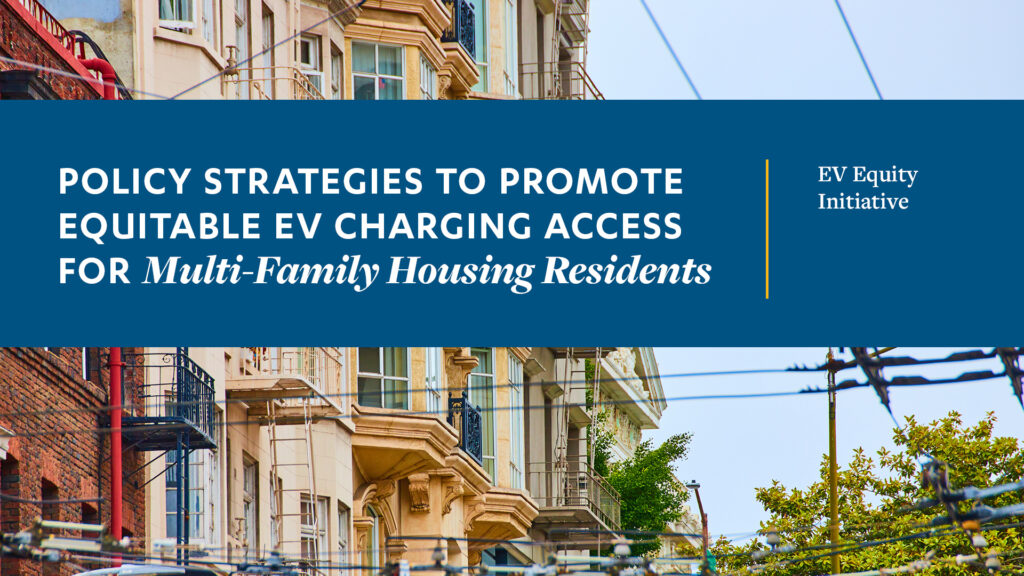EV Charging Access for Multifamily Housing Residents
New CLEE report highlights key findings for equity-oriented program design
The rapidly approaching electric vehicle (EV) transition that California and a dozen other states have committed to enact over the coming decade mounts pressure on state and local governments to deliver millions of new EV chargers across various location types. Homes constitute the core of a convenient and reliable charging network, and EV charging infrastructure in multifamily housing and multi-unit dwellings (MFH and MUDs) in particular will serve a vital role in ensuring an equitable clean mobility transition.
The ability to fuel vehicles at home represents one of the clean mobility transition’s most significant, practical enhancements to passenger vehicle driving and mobility. Various cost and convenience benefits of at-home charging leads EV drivers to characterize their residence as the most important location for their charging needs. However, heightened barriers to EV charger installations at MUDs have largely restricted the recent growth in residential charging access to single family households; while 80 percent of EV charging occurs in drivers’ homes, less than 5 percent of charging occurs in MUDs. Three key charging barriers for MUD residents include:
- High installation and operational costs required for EV charging in MUD parking areas (and in public spaces for MUDs that lack onsite parking); middle- and lower-income multifamily housing residents and building owners often lack the financial resources to take on new capital investments and fees associated with charging infrastructure.
- Low EV demand and awareness among MUD residents and building managers; limited knowledge about new EV infrastructure, potential long-term cost savings, and funding opportunities strains residents’ ability and incentive to navigate EV charging installations and ongoing operation.
- Limited electrical and network capacity, particularly in older MUD buildings; retrofitting requirements prevalent in lower-income buildings with dated infrastructure generate the bulk of financial challenges associated with MUD charging installations.
The current lack of electric vehicle charging at MUDs limits the ability of their residents, particularly in lower-income and dense urban communities, to access the health and financial benefits of this clean technology. Without equitable access to charging at or near their homes, MUD residents are at risk of paying significantly more for less convenient charging than single-family home residents.
CLEE’s new report, informed by interviews with program officials and multifamily residential charging experts, draws insights from 31 case studies of MUD charging projects and programs to identify equity-oriented solutions to the three charging barriers highlighted above. The case study analyses focus on strategies with greatest potential to advance equity in EV charging expansion among MUD residents, and the brief proposes additional elements to enhance strategies’ equitable reach and implementation.
Some key findings include:
- Grants, rebates, and other incentive programs require equity-focused allocation methods to reach all residents and deliver equitable outcomes.
- MUD-specific electricity rates can address inequities in charging prices by more closely matching residential rates that single-family households face.
- EV ownership incentives and accommodations for MUDs with low near-term charging demand can improve charger accessibility and help jumpstart EV adoption.
- Targeted stakeholder outreach is crucial for equitable participation in incentive programs.
- Load-balancing charging equipment can help minimize electrical upgrades but also reduces user convenience. Potential inconveniences associated with load-management technology should be offset by lower prices and/or supplemental charging and mobility options beyond the MUD.
- Community ownership and investment models should accompany EV charging installations to address displacement concerns.
This brief is intended to guide local government leaders, building managers, and other stakeholders involved in the planning and installation of charging infrastructure at and near multifamily residences. With collective efforts to prioritize MUDs in incentive programs, utilize cost-minimizing technologies, and extend educational and ownership opportunities to building managers and residents, MUD communities can share the many benefits of a clean mobility transition.
CLEE developed this brief as part of its EV Equity Initiative, which seeks to build locally tailored, community driven, and replicable approaches to the development of electric vehicle and mobility infrastructure in underserved communities in California and the US. The brief is the second in a series of CLEE papers (following our Curbside Case Studies report) that focus on equitable practices in key areas of EV infrastructure development. These papers will serve as in-depth resources for various parts of CLEE’s EV Action Plan Framework – coming out later this year.
Access the full report here: Policy Strategies to Promote Equitable EV Charging Access for Multifamily Housing Residents
Reader Comments
5 Replies to “EV Charging Access for Multifamily Housing Residents”
Comments are closed.








California commits to EVs even as Tesla kicks California, and despises everythign California stands for. WHatever dude.
The great big lie is that EVs mitigate climate change. EVs have no effect on climate and do not reduce the global atmospheric temperature at all.
If we add all the EVs in the world to all the solar panels and wind mills, there is still no measurable impact on climate. Climate mitigation is a corrupt fraudulent rip-off. Hurry November, abolish Kamala.
Does a tiered rebate program cost less because fewer people use it? Or are they able to serve the same or a greater number of drivers, with less money?
When is the $20,000 per charger amount going to come down to something feasible?
When can I put a solar panel on my car? How much will it cost?
I didn’t know apartment renters were getting hammered on electricity costs – that’s a giant bummer.
No offense, but although this is a very interesting topic, it also seems like kind of a nightmare. Let’s hope the costs drop soon!
Would it be easier at all to just have modular batteries and go around distributing charged ones? Or would that just be a different nightmare?
Plus I suppose we are not there yet, with the tech?
Plus we need to clean up the whole battery scene. That won’t be easy either is my guess.